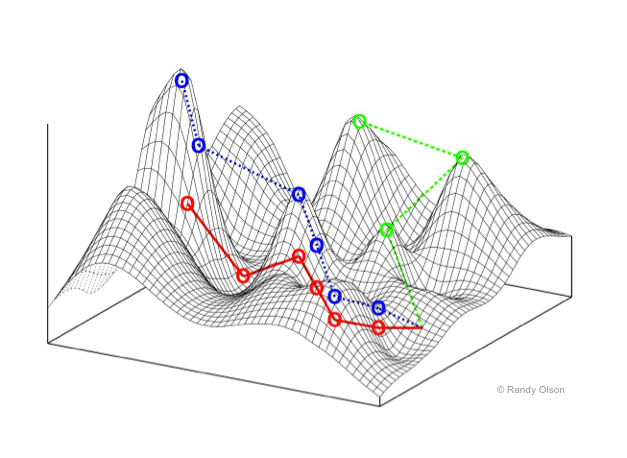Landscape of strength training - borrowed idea to aid a discussion
Knowledge as a whole is often aided by a cross-pollination of ideas from one discipline to another. I don't exactly know what brought on the idea, but I was first introduced to the idea of local maxima and minima in high school math, and it was further applied to evolution and then Sam Harris' The Moral Landscape, at least in my experience of the idea.
Here we apply to same concept to areas of strength training, in hopefully allowing us to understand things a little bit more. I view strength training as a rugged terrain, similar to an infinite expanse of the picture shown above, with peaks and valleys--some higher than others. The y-axis here, though the term "fitness" is used, is used instead to describe the fitness of a species to survive and pass on genetic information in a specific environment. For our purposes, the y-axis can instead represent many desirable qualities for an athlete: strength, powerlifting total, mastery of technique, Wilks score, etc. For each one of these y-axis characteristics, the local maxima take on different attributes as well. Perhaps if we are talking about technical mastery, one local maxima is figuring out the right foot stance you will use in the squat, or perhaps it is hip drive in the bench press. If we're talking about powerlifting totals, perhaps one local maxima is a 1500 lb total. The idea is that we are searching for ever higher peaks as time goes on.
As athletes, we are wanderers on this terrain, searching for the global maximum, where that global maximum represents our strongest form of ourselves that invariably is a combination of training age, opportunity, work, and luck. Our search is not a random one. Assuming we keep the y-axis as some combination of those desirable attributes noted above, our search is guided by experience, our social backdrop, science and application, and again, luck. I'll briefly go over these.
Experience
We use our experiences to form ideas about strength training, based on what has been successful for us in the past, in both technique in the lifts and in programming and periodization. Low bar squat has worked for Athlete X in the past, so she continues to use it today, influencing her movement across the landscape. Daily maxing the squat has not worked for Athlete Y, so he stops using it, influencing his movement across the landscape. At every point, our experiences are forming our beliefs about what constitutes a good approach in strength training (hopefully informed by reason and science), and therefore limits which peaks we are even interested in climbing. Athlete Y is not apt to even think about climbing the "Daily Max" mountain, even if it may lead to a local (or global) maxima. Its simply the way of the world that we are limiting ourselves to pursue certain avenues in training, and avoid others.
Social Backdrop
This plays a larger role than I think people are aware. Dan Green gets popular and has a specific style in the deadlift, people see that and start using it in response. DUP gets popular, people see it and start using it in response. Your friend John gets great results from Westside. Your friend Alex loves the SBD Knee Sleeves, and so on. There are hundreds of social memes (used here in Dawkin's original sense, "an idea, behavior, or style that spreads from person to person within a culture.") that influence us without our knowing at times, and its important to at least admit this is happening.
Science and Application
This is probably the most self-explanatory, but science trickles down and becomes applicable enough to influence strength athletes as a whole. It almost always first has to pass through the social backdrop in the form of an experience like "John's approach uses a modified Prilepin Table specifically for the deadlift, and it works for him."
Luck
Luck! Sometimes we plain old stumble upon the base of the mountain whose peak is the global maximum, and all that's left to do is a hefty, long climb to the top, without suffering through the landscape itself. Or sometimes we find ourselves on a local maximum, and there's a gondola that can take you straight to the peak of another maxima. I was lucky enough to stumble onto the base of a tall mountain early on, and my trek up that mountain was not a difficult one.
The Search
If we have to wander the landscape, which is inevitable if what we're trying to do is become more refined, stronger, better athletes, then in the least we ought to inform our movement by a careful consideration of the above qualities. Movement is costly from a standpoint of time, and unlike the genetic counterpart to this example, we don't simply have to proceed at random (though it's a further question whether random movement would produce better results).
Some peaks may not even be worth the travel, if the peak is low and it takes a long while to get to. Some peaks may be necessary to climb before reaching even higher. The parallels with strength training here are not only fun to think about, but rewarding as well, and we would do well to consider the analogies between genetic fitness and strength and conditioning, as a tool for discussion.
The analogies that can be drawn here are wide and varied, and it's a tool I'd like us as a community to use to a greater degree, because it makes us aware of the vast realm of possibility. A few simple things to follow:
Don't be disappointed if, after reaching a local maxima, you have to go downhill before ascending another peak.
Don't be wholly satisfied at a local maxima--there are greater peaks to find, and a long time with which to find them
Enjoy the journey! If we are only happy when we find ourselves at a local maxima, we are missing 95% of the journey.
Thanks,
Bryce Lewis


